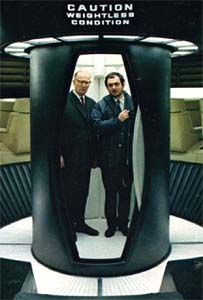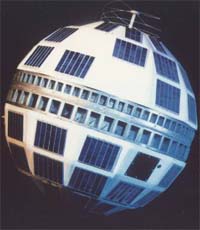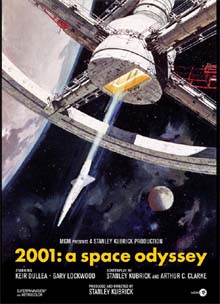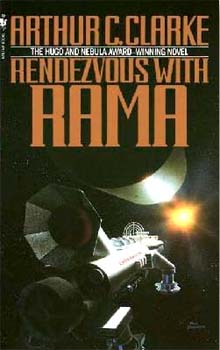pop up description layer
HOME
Cryptozoology UFO Mysteries Aviation Space & Time Dinosaurs Geology Archaeology Exploration 7 Wonders Surprising Science Troubled History Library Laboratory Attic Theater Store Index/Site Map Cyclorama
Search the Site: |
|
Notes from the Curator's Office The Big Three: Arthur C. Clarke
The conclusion in our series about the "Big Three" Science fiction writers of the 20th century. (11/07) Of the so-called "Big Three", Arthur C. Clark is the only writer still with us. He turns ninety years of age this December. Clark was already a huge figure in science fiction when I was a kid and I remember being riveted by his books: A Fall of Moon Dust, 2001: A Space Odyssey and Earthlight. Although I have never met Mr. Clarke, I admit I feel a special connection as we're both included as authors in the anthology Stranger Than Fiction. Early Life Clarke was born on December 16, 1917, in Minehead, Somerset, England. Despite being a bright student, Clarke was unable to afford a university education and instead found a job as an auditor. During this period he started writing amateur stories for fanzines. His work as an auditor was interrupted by World War II when he joined the Royal Airforce as a radar specialist. He was involved in the famed "Battle of Britain" in which a small number of Royal Airforce planes, aided by radar intelligence, successfully defended the country from numerically superior German forces. After the war Clarke earned a degree in mathematics and physics at King's College London. At the same time Clark became involved with the British Interplanetary Society and actually served as its chairman for a while. During this period Clarke came up with the idea of the geosynchronous telecommunications satellite which was to revolutionize global communications. Clarke figured out that if you put a satellite in orbit 22,300 miles above the earth's surface, it would go around the planet at exactly the same speed the planet was turning. If you also placed it over the earth's equator in a geostationary orbit, it wouldn't move at all relative to earth's rotation. This meant that to an observer on the earth's surface, the location of the satellite would remain fixed in the sky. This permitted radio beams to be transmit to the satellite, which could then retransmitted any messages to locations beyond the reach of the initial earthbound transmitter. With a few satellites working together, it would be possible to have near instantaneous communications from anywhere to anywhere around the globe. Today there are nearly 300 geosynchronous satellites in earth's orbit. If you get your tv from an antenna dish (as I do) you have Arthur C. Clarke to thank.
2001: A Space Odyssey In 1946 Clarke had his first professional stories - Loophole and Rescue Party - published in Astounding Science Fiction magazine. This was followed by The Sentinel which was written for a BBC competition. Though he didn't win, Clarke later showed the story to visionary director Stanley Kubrick. Kubrick and Clarke then worked together to develop The Sentinel into a movie script that was finally titled 2001: A Space Odyssey. A novel, written by Clarke, was also planned to precede the movie's 1968 release, but in the end it came out simultaneously. In the movie, scientists find an alien artifact buried on the moon. When exposed to sunlight for the first time in millions of years it beams a powerful signal out to Jupiter. The scientists realize they have just sprung an alarm and send an exploration ship off to Jupiter to see just where the signal went. Unfortunately the ship has onboard an intelligent computer with homicidal tendencies that kills most of the crew. Only one astronaut is left alive to discover a secret at Jupiter that leads man to his next level of evolution. At the time that it came out, 2001 was one of the most striking films ever made. The story, which mainly takes place on the surface of the moon and later on the exploratory spaceship bound for Jupiter, was told with little explanatory dialog, forcing the audience to piece together the plot for themselves. At the time the movie was made, the space program was just starting to provide the public with real images of the earth and spaceflight hardware in orbit and Kubrick took great pains with his special effects to make sure they looked authentic. While the movie got mixed reviews when first released, over the years many critics have named it as one of the best films ever made. Book Themes The theme of the film and book -- the human race coming into contact with advanced alien intelligence - is echoed in a number of Clark's most famous works: Childhood's End, Rendezvous with Rama and Cradle (written with Gentry Lee). Clarke also produced some good, "hard science-fiction" in the form of straightforward adventures without intelligent aliens, too. These include A Fall of Moondust (the rescue of a group of lunar tourists), Earthlight (a short war between Earth and the outer planetary colonies over resources on the moon), A Meeting with Medusa (exploration of Jupiter) and The Hammer of God (earth under threat of an asteroid impact). Not all of Clarke's fiction is space based, either. He has a strong interest in the sea and for many years was an avid scuba diver and a member of the Underwater Explorers Club. He even owns a scuba diving school. The Ghost of the Grand Banks (exploration of the sunken Titanic), Dolphin Island and Cradle all take place for the most part beneath the ocean.
Clarke has written sequels to several of his books effectively turning these into series. For example: 2001 was followed by 2010: Odyssey Two, 2061: Odyssey Three and 3001: The Final Odyssey. (2010 was also made into a movie). Rendezvous with Rama was followed by Rama II, The Garden of Rama and Rama Revealed (all the sequels with author Gentry Lee). Clarke has also written non-fiction too. Early on he had a significant interest in the supernatural though he has grown skeptical over the years (He admitted that he was once fooled by pseudo-psychic Uri Geller). Still, many people were introduced to the world of the unknown via television shows he was connected with: Arthur C. Clarke's Mysterious World and Arthur C. Clarke's World of Strange Powers. Since the 50's Clarke has resided in Sri Lanka where he is considered a bit of a national treasure. He maintains a duel citizenship both there and in Great Britain, and the British, in May of 2000, honored him with a knighthood. Not to be outdone in 2005 Sri Lanka presented Clarke its highest civilian award the Sri Lankabhimanya (translated as The Pride of Sri Lanka) for his contributions to science. His current tropical island home has also inspired the supposed location for his book The Fountains of Paradise which is the fictional history of the building of the first space elevator. The idea of an elevator with one end anchored on the ground and the other at a station in geostationary orbit in space didn't originate with this novel but it has brought the idea to the attention of many people. Clarke himself stated that if there is a legacy to his work in technology he expects it not to be the communications satellite, but the space elevator. Rendezvous with Rama In my opinion, Clarke's finest work isn't 2001, but Rendezvous with Rama. It is an adventure novel which catches the reader's imagination and doesn't let go until the very end. Rama is the story of the captain and crew of an asteroid scouting ship that find themselves the only earth vessel capable of intersecting and exploring a gigantic alien spaceship as it hurtles through our solar system and on out into deep space. The crew has barely two weeks to examine this strange world and try to figure out who made it (and why) before they have to depart and the opportunity is lost forever. The book was been one of Clarke's most popular (it won both the Hugo and Nebula awards) and was followed by three sequels which unfortunately do not quite live up to the original.
Clarke suffered from polio as a child and as a result has spent much of his time in a wheelchair since 1988. Still, he continues to write, though often in conjunction with a junior author. Most recently this has been Stephen Baxter, a well-known science fiction writer in his own right. Together they have most recently authored the series of Time Odyssey books. I'll close this article with two quotes, the first from Clarke himself because it is simply one of my favorites and I think it illustrates Clarke's interest in both science and the paranormal: Any sufficiently advanced technology is indistinguishable from magic. The second is a tongue-in-cheek tribute to Clarke from his sometime rival and fellow member in the exclusive Big Three club, Isaac Asimov: Arthur and I share similar views on science fiction, on science, on social questions, and on politics. I have never had an occasion to disagree with him on any of these things, which is a credit to his clear-thinking intelligence. Well, if Isaac Asimov thinks Clarke's a pretty smart fellow, who am I to disagree? Links to Isaac Asimov and Robert Heinlein. Copyright Lee Krystek 2007. All Rights Reserved. |
|
Related Links |
|
|






